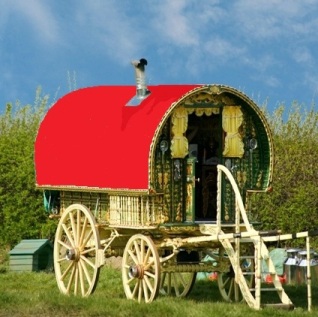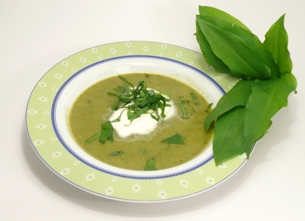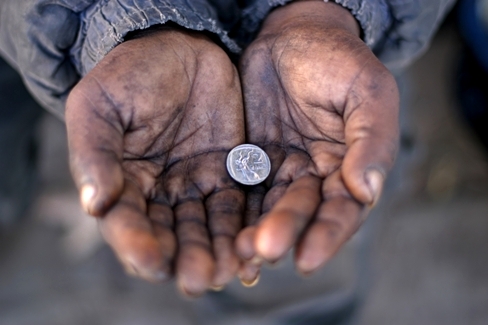“We always knew the Gypsies were coming when we heard the light tinkling of silver bells coming up the lane. The sound of the bells was delicate and light and fell in rhythm with the trot of the horses pulling the covered wagon. We didn’t know where they came from, there were no Gypsy encampments nearby, but they came to the house two or three times a year to see my mother. The wagon was wooden and plain with a brightly colored canvas cloth of red or orange covering the rounded roof. One man drove and cared for the horses during the visit and two women accompanied him. One woman came to our house and the other would go to see the neighbors. The women were always highly dressed in long skirts in dark but bright colors. They always wore head scarves and had dark skin – an olive color – they were not pale like us. As to jewelry, the only thing I could see from a distance were big hoops in their ears of silver and gold.
It was an exciting time when the Gypsies came. My mother would always send us out of the house. We weren’t allowed to watch or even hear what was going on. My sister and I would hide in the fields to watch the wagon and the women come and go. The man never came into the house. He stayed with the wagon and the horses while the women conducted business. We knew my father wouldn’t approve, but he was out working and wouldn’t ever know that they had visited. We never told him, and knew our mother wouldn’t either. My mother told us that they came to tell her fortune, but sometimes they also sold her things like herbs and plants. One time I remember, they left a snake plant on a beautiful handcarved stand. My mother cared for the plant throughout her life. When I was little she wouldn’t ever tell me what it was for, and would say that it was just a plant, nothing special. When I grew to be a woman, she told me that the plant protected the family from spells and bewitchment.”

These words are my mother’s recollections of the visits of the Roma or “Gypsies” to her home in the 1930s and 1940s in what was then still rural Westchester County, New York. She grew up in a German-American community, aptly named Valhalla, and her father helped build the large dam nearby that held the waters that quenched the thirst of New York City residents some 40 miles or so to the south. Her mother had been a woman of the world and travelled from her native Germany to Russia, trans- Caucasus to China and back to Germany before performing in Latin America. A global circuit she did many times in her young life before she settled down in her late 30s to marry and have my mother and her sister. As a girl and a woman travelling in the early 20th Century, she saw many exotic peoples and places as she moved around the world; the Roma are some of those she encountered. The story of the Roma peoples is one born on the Western Silk Road. It is a story that runs like a river from Southern Asia through the Caspian and Black Sea countries to the far ends of Europe.
The Roma were an amalgam of peoples who moved westward out of northern India sometime in the 10th Century. They passed through Persia and the remnants of Byzantium and reached the Eastern border of Europe by the mid-to-late 13th Century. From there they radiated across the continent by about 1500. Many unlucky Roma wound up enslaved in the Balkans – a servitude which for them and their descendants lasted until the mid-19th Century. While all Gypsy populations retain a more or less shared cultural and linguistic core, their fragmentation after they reached Europe seven centuries ago has led to emergence of many distinct groups. Thus, no description of the life and customs of any one group can possibly hold true for all Romani people.

One of the central cultural aspects shared by most Romani people is the division of the world into pairs or opposites: Good – Evil; Clean – Unclean; Day – Night; Gypsy – Non Gypsy, etc. Notions of ritual pollution of the body and its links to social ranking show clear links with Indian caste beliefs, but the division of world into dualistic pairs might also show some linkages with Zoroastrian practice as well.
In terms of food and dining practices, the concept of purity and pollution have led to some interesting practices such as picking up small bits of food with their fingers or a piece of bread, pouring liquid into their mouths without touching their lips with the vessel or glass, and sharing a smoking pipe, but clenching their fist around the end of the pipe, instead of placing the pipe stem directly in the mouth.
Because of life on the move, the majority of Roma have been obliged to find food in the wild: small animals, fruit, nuts, and berries in the woods; fish in the streams; roots and leaves from the forests and fields. Traditionally, Roma catch fish by crouching by a river until a fish swim into their hands, the fish are stroked and then tossed quickly onto the bank; wood fowl, chickens and other game are caught using a whip. Horsemeat is generally, but not universally rejected, probably because of the importance of the horse to a mobile lifestyle, snakes are never eaten because of their negative symbolism, and dogs are not consumed because they are considered unclean.
Methods of food preparation have been similarly contingent upon circumstance. Thus stews, unleavened breads, and fried foods are common, while leavened breads and broiled foods, are not. A meal is traditionally served upon a large tray, perhaps made of brass, set on a cloth on the ground or raised on a low stand; a table is, however, sometimes used. Traditional Roma cooking is done in open kettles, copper pots, or frying pans. These are held over the fire by a chain and hook and set on a stand for serving. When the availability of provisions permits, there are traditionally two meals each day–one shortly after rising and one in the late afternoon. Coffee is widely consumed across the course of the day and can be made from purchased beans or from dandelion roots or other herbs.
Some foods are considered especially beneficial or lucky. Food of this kind consists of items that are either strong-tasting or bright-colored, such as chili, black pepper, garlic, lemon, pickles, vinegar, or salt. Meat is always eaten first and then vegetables are eaten one at a time until each one is consumed.

Deciphering what specific recipes are “Gypsy” and which ones are European with a Gypsy flair or preparation is very difficult. Very often recipes are labeled “Gypsy” that are really Romanian or Hungarian in origin. A soup or stew from wild-gathered items such as the bear leek soup pictured here might be a typical traditional Roma dish, even though it is also eaten widely across Central Europe as well. Small game and birds – like hedgehogs and wild waterfowl strung on hazel-wood sticks and grilled over an open flame like kebabs is another Roma-type dish. Stews made of venison, rabbits or other game cooked with plentiful tomatoes and peppers are often called Roma. Garlic and onions or leeks are plentiful as are chili peppers and herbs for flavor and lemon or vinegar for souring. Vegetables are also often cooked in a meat stock or some sort to add flavor and nutritive value.
So do some research and cook some stews and enjoy the food of the Roma – one of the many peoples in the intricate patchwork of the Silk Road. (Words by Laura Kelley and EAC. Photo of Roma Hands by Noltelourens at Dreamstime.com; Photo of Roma Covered Wagon by Nedetojoneil at Dreamstime.com; Photo of Roma Girl by Akarelias at Dreamstime.com; Photo of Bear Leek Soup by Twilightartpictures at Dreamstime.com)

